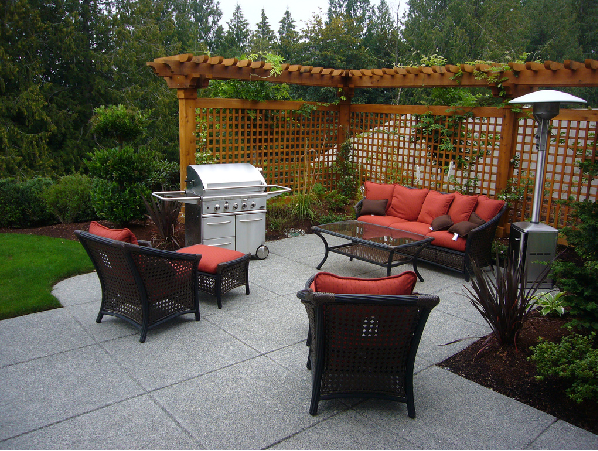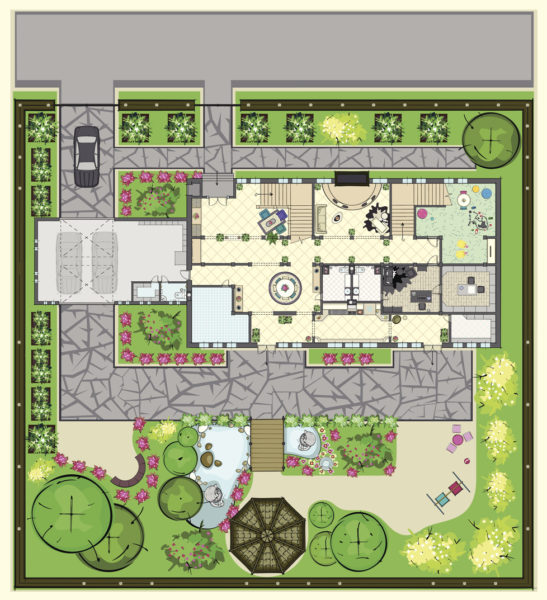Creating a relaxing outdoor living space in your home, either in your front or backyard, greatly increases the appeal of your home. It is also one of the top ways to increase the value of any property for those thinking of putting up their homes for sale.
Patios and outdoor rooms can be designed to provide stylish and comfortable havens for your family and friends who enjoy outdoor living in the form of spaces or rooms that are meant to ‘bring the interior out to the exterior’ while surrounded by natural elements and features like foliage, stones, rock, ponds, logs, and fountains, including furniture, furnishings, and amenities typically found indoors.
While some patios are carved out from small spaces with just enough space to place a couch, small coffee table, and an accent chair, others are large enough to contain built-in furniture, a fireplace, ceiling fan, an array of potted plants, a barbeque pit, a wet bar, floor rug, and even a large screen television.

Patios and Design Guiding Principles
If you are planning towards designing and building a small patio or larger outdoor living room, what are the things you’ll need to consider?
First, let me tell you 4 guiding principles you’ll need to consider before starting the task. Following these very basic design principles will go a long way in ensuring the successful implementation of your design.
- Unity
- Variety
- Balance
- Proportion
1. Unity
What this means is that you should ensure every feature and element works well together so there is unity in your design concept. Floor finish, overheads, and screens if you require these must complement each other. The furniture you should look for is those best suited to the patio’s architectural style and features and the same goes for your choice of foliage too. Pants must be in harmony with themselves and the other greenery of the outdoors.
Additionally, it is good to design your outdoor living space to be in tandem with the architectural style of the main house.
2. Variety
Having a form of unity in the patio’s design concept (as mentioned above) doesn’t mean there shouldn’t be an aspect of variety because, without variety, unified forms will appear monotonous and somewhat bland.
For instance, to add an element of surprise to your design, a path that leads from a main outdoor living room floored with paving stones to a smaller, cosier, patio paved with the same, can be designed with different wood deck levels to arouse visual interest.
Variety can also be used to generate interest on vertical surfaces. The spaces can be set at different levels, flower beds can be raised and decorative privacy screens can be installed to draw the eyes away from any bland horizontal expanse of space.
3. Balance
In patio design, a balance is applied when elements placed in its space are artfully combined to produce a similar ‘visual weight‘ on both sides of a central piece.
A good example is balancing a mature tree on one side of the patio with perimeter-lined patio benches on the other side, or in the case of small patios, balancing a garden pool on one side with accented plants and patio furniture on the other.
4. Proportion
Scale and proportion demand that the patio or outdoor room be in a comparable relationship size-wise with the building and surrounding garden. Because outdoor leisure spaces are not interior spaces, sizes and forms of typical features used outdoors must work well with everything that surrounds them.
Other forms and features such as standalone or built-in planters, wet bars, barbecue equipment/pit, etc… if introduced, should have scales proportionate to every other thing on the patio.
To maintain proportion in a small patio, for instance, it is good to keep its design simple, clutter-free and with clean lines that will make the design elements appear larger. Use moderately sized patio furniture such as the built-in variety, to avoid a cluttered crowded feeling. Use plants or any other foliage with restraint, because some plants like the poplar tree may look just right now but don’t forget that they will become too tall and overbearing for the patio within just a few years down the line.
9 Things to Consider Before Designing Outdoor Leisure Rooms
As we all know, the rising values of properties have gradually limited residential plot sizes over time. However, even if you don’t have that much space to create a sizeable outdoor room, with some imagination and careful planning, you can transform any space, no matter how small, into a nice patio.
Before creating a patio, consider:
1. Space – How much available space do you have?
Being able to create beautiful small outdoor spaces depends on the available space you have. If for instance, your plot is small, you may wish to consider building the structure attached to your house. This can be positioned off the kitchen, the dining or the living room.
If the house is U-shaped or L-shaped, the room can link and visually expand two or three interior rooms without taking up additional outdoor space.
2. Location – Where is this space located? The front, back, or side of the building?
If you have space in the front portion of the house, perhaps the outdoor room belongs there. For privacy from outside prying eyes, it can be protected from the street with a vertical screen made up of potted shrubs, and trellis panels made from wood with creeping vines like jasmine or bougainvillaea. It can be sited at the back of the house if you have ample space in which case it can lead from the kitchen. And if your garden is in the back of the house, you can build the leisure room there.
3. Access – Does it have any access point say from the dining room, master bedroom, or from outside only?
An outdoor room doesn’t necessarily have to have borders made from brick walls, but it must have some border of sorts. Decide on what materials or features you’ll love to serve as borders. Borders can be created with potted flowering plants, built-in benches, storage containers, perforated walls, folding glass walls, waterfalls walls, or custom-built barbecues or fireplaces with chimneys.
The more you use the room, the more accessible you want it to be without disrupting your normal routine. The first step to creating a well-planned outdoor room is to determine your access points. If it is not attached to the house, like maybe built at the far end of the garden, you can create a natural path from the back door to the leisure room. The walkway can be made with large stone pavers like flagstones, cobblestones, or burnt floor bricks.

4. Borders – Is the space bordered by trees, a next-door fence, a tools shed, or the road?
An outdoor room doesn’t necessarily have to have borders made from brick walls, but it must have some border of sorts. Decide on what materials or features you’ll love to serve as borders. Borders can be created with potted flowering plants, built-in benches, storage containers, perforated walls, folding glass walls, waterfalls walls, or custom-built barbecues or fireplaces with chimneys.
5. Weatherproofing – Will you require a form of weatherproofing? From the rain, intense sun, or the cold?
Some outdoor rooms are not entirely enclosed and are partly exposed to the weather conditions so you need to choose your furniture and furnishings wisely. If yours is such that’s enclosed, for instance, with three borders, then you will need to use materials that can withstand moisture from the atmosphere, dust, and dirt. Materials to consider include bamboo, rattan that’s been weatherproofed, teak, and durable iron such as wrought iron.
6. Furniture and furnishings
You can make yours look like a family living room, an entertainment room, or a children’s playroom. What you decide to create depends on the reasons why you’ve decided to have one. Furniture and furnishings should be chosen based on these reasons.
Let’s say, for instance, you desire a living room setup, elements you will need must include a couch, accent chairs, a coffee table and side tables, and throw pillows. You can add simple furnishings or tasteful ones. It all depends on your style. Don’t forget scented candles, table-top water features, memorabilia, coffee table décor, and other decorative objects of your choice. There is no one way to style your outdoor leisure room. Include table lamps or hanging lanterns.
Because you are trying to have the same comforts of your home, but in an outdoor setting, consider installing an outdoor TV and/or a wet bar but remember to choose items that correspond with the size of the room.
7. Lighting – Do you plan to use conventional light fittings/fixtures or candle, lantern, or waterproof wicker floor lights?
Take a cue from the surroundings when planning on how to light up the room at night. If you live along the coast, get table lamps set in a trough of beach sand and starfish or ones filled with seashells. A lamp filled with seashells or made from a buoy brings the beach to mind.
And if you live in a wooded area or the mountains, for instance, choose one crafted from faux antlers, log stumps, or rustic stained glass. Hanging lights are also essential. You can have a singular central hanging light or decorative wicker lanterns. If your leisure room leads out to a pathway, think about pathway lighting too. If you have trees close by, illuminate them with landscape lights.
8. Heating – If you have a patio screened off well enough, will you require heating for the colder months?
You want to enjoy your outdoor room even when it’s cold or wet outside. In the colder months, you need adequate heating that will ensure the space is relaxing and cosy all year round.
Simple, cost-effective and instant, a convection heater warms the air through heated elements and is quieter than a fan heater. That’s not to say you can’t use a fan heater though. Log-burning stoves are another great option and a beautiful way to heat your outdoor room and if the room is fitted with laminate or wood flooring, you can install an electric underfloor.
You may also consider maintenance-free bio-ethanol fires. You won’t need a flue or hearth because they are self-contained and are fed by clean-burning eco-friendly bio-ethanol liquid and best of all, you don’t need to connect to any services.
9. Colour scheme – Have you thought about having a defined colour scheme for your patio design idea?
Get creative with your colour scheme. Use a bright rug to liven up space and neutralize it with a concrete coffee table. Large lanterns on the floor with coloured candles help create a visually warm ambience. Boldly (or subtle, depending on what you like) patterned or textured oversized floor cushions are a change from your more staid interior look. Introduce green foliage set in large planters for a warm natural look.